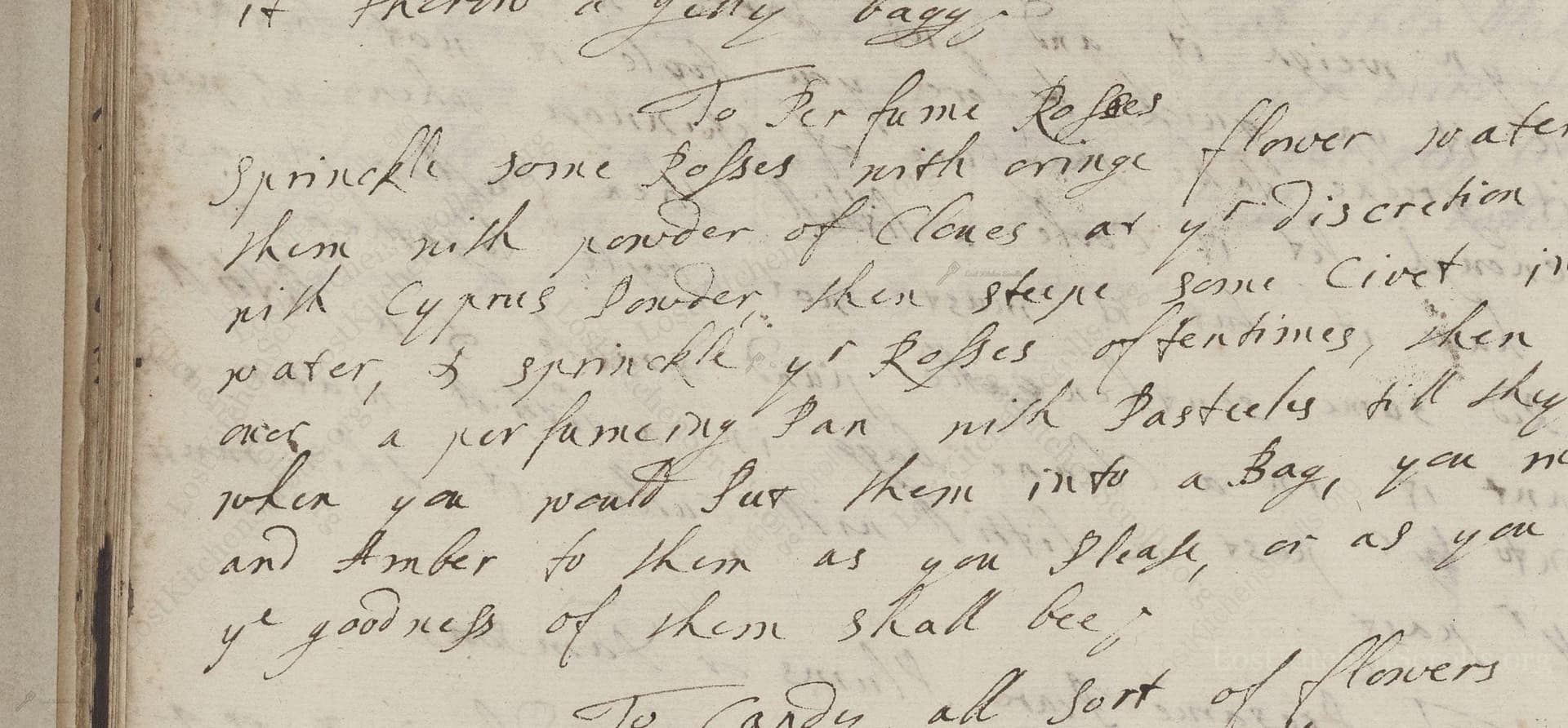To Perfume Roses
From the treasured pages of Receipts in cookery and medicine 1700
Unknown Author

To Perfume Roses
"Sprinckle some Roses with orange flower water & pouder them with pouder of Cypress, & sprinckle yr Clones at yr discretion after that with Cypress pouder, then steepe some Civett in orange flower water, & sprinckle yr Roses oftentimes, then set them on a perfuming pan with Pasteles till they be dry then when you would put them into a bag, you may put Muske and Amber to them as you please, or as you would have ye goodness of them shall bee."
Note on the Original Text
The recipe is written in early modern English, characterized by free spelling ('sprinckle,' 'pouder') and little punctuation. Measurements are non-specific and based on the maker’s judgment and desired intensity. Directives jump between actions—sprinkling, steeping, drying—without set order or quantities, reflecting the era’s trust in the experienced hand rather than fixed recipes. The language is evocative but assumes familiarity with luxurious perfume materials.

Title
Receipts in cookery and medicine 1700 (1700)
You can also click the book image above to peruse the original tome
Writer
Unknown
Era
1700
Publisher
Unknown
Background
Step into the kitchen of the early 18th century, where this charming culinary manuscript tempts tastebuds with recipes and secrets from a bygone era. A delicious journey for both the curious cook and the history lover.
Kindly made available by
Folger Shakespeare Library
This aromatic recipe hails from circa 1700, during a period when personal and household perfumery was in vogue among the nobility and upper classes. Scented sachets, known as 'pomanders' or 'sweet bags,' were prized for warding off unpleasant smells and demonstrating sophistication. The use of exotic ingredients like civet, musk, and ambergris speaks to the global luxury trade of the time—a heady era of sensory indulgence just before the rise of industrial perfumery.

Historically, a perfuming pan (gentle chafing-dish or brazier) was used to dry fragrant materials, alongside ceramic bowls for steeping and small pestles for grinding resins and spices. Fine cloth or muslin bags served as the final vessel for the perfumed mixture, turning loose petals into portable luxury.
Prep Time
10 mins
Cook Time
2 hrs
Servings
1
We've done our best to adapt this historical recipe for modern kitchens, but some details may still need refinement. We warmly welcome feedback from fellow cooks and culinary historians — your insights support the entire community!
Ingredients
- 3.5oz fresh rose petals
- 1 fl oz orange blossom water
- 2 teaspoons ground Cypress powder (substitute: ground dried rosemary or juniper needles)
- Pinch (1/8 tsp or 1/64 oz) ground cloves
- 1 drop synthetic musk or civetone diluted in 2 teaspoons (0.33 fl oz) orange blossom water (substitute for civet)
- Scant 1/8 tsp or less than 1/16 oz powdered musk (substitute: drop of musky fragrance oil)
- Scant 1/8 tsp or less than 1/16 oz powdered ambergris (substitute: drop of amber fragrance oil)
Instructions
- Begin by selecting fresh rose petals (about 3.5oz), and lightly mist them with orange blossom water (approximately 1 fl oz).
- Gently dust the petals with ground Cypress powder (if unavailable, finely ground dried rosemary or juniper needles, about 2 teaspoons, may be substituted) and optionally sprinkle in a pinch of ground cloves (1/64 oz or about 1/8 tsp) to your liking.
- Prepare a small amount of civet substitute (such as a drop of synthetic musk or a drop of civetone, as animal civet is now protected and unavailable), diluted in 2 teaspoons (0.33 fl oz) orange blossom water, and gently mist the rose petals again, repeating the process several times for a deeply perfumed result.
- Allow the petals to dry by placing them over very gentle heat—use a baking tray lined with parchment, set in an oven at the lowest setting (around 120°F), or use a dehydrator, letting the petals dry slowly until just crisp.
- Once completely dry, transfer petals to a muslin or sachet bag, and add a small pinch each (less than 1/16 oz or a scant 1/8 tsp) of powdered musk and ambergris if available (both can be substituted with a drop of natural or synthetic musky or amber fragrance oils).
- Store sealed in a cool, dry place for use as a perfumed sachet or potpourri.
Cooking Estimates
You will spend about 10 minutes preparing and scenting the rose petals. Drying takes about 2 hours at low heat. This recipe does not contain significant calories, as it is not meant for eating.
As noted above, we have made our best effort to translate and adapt this historical recipe for modern kitchens, taking into account ingredients nowadays, cooking techniques, measurements, and so on. However, historical recipes often contain assumptions that require interpretation.
We'd love for anyone to help improve these adaptations. Community contributions are highly welcome. If you have suggestions, corrections, or cooking tips based on your experience with this recipe, please share them below.
Join the Discussion
Rate This Recipe

Den Bockfisch In Einer Fleisch Suppen Zu Kochen
This recipe hails from a German manuscript cookbook compiled in 1696, a time whe...

Die Grieß Nudlen Zumachen
This recipe comes from a rather mysterious manuscript cookbook, penned anonymous...

Ein Boudain
This recipe comes from an anonymous German-language manuscript cookbook from 169...

Ein Gesaltzen Citroni
This recipe, dating from 1696, comes from an extensive anonymous German cookbook...
Browse our complete collection of time-honored recipes



